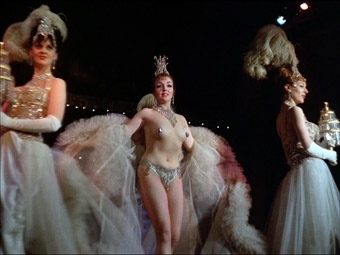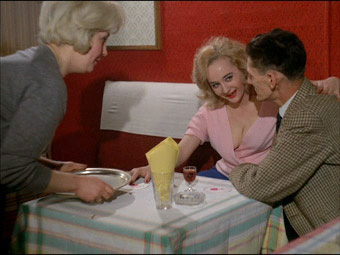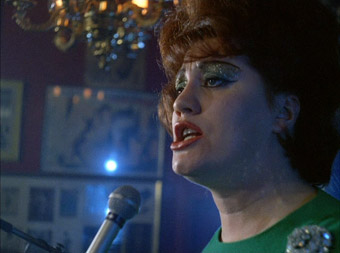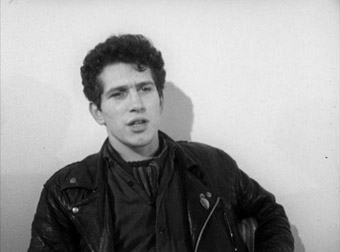|
Many of you will be too young to remember the horrors of what was known as the Full Supporting Programme. It existed in a transitional period between when cinemas stopped showing feature double bills and the single feature screenings of today, and usually consisted of a short film designed to convince you that you were still getting value for money now that the supporting feature was getting a seperate screening of its own. For the most part they were horrible things, often banal travelogues produced by the likes of Global-Queensway, or a celebrity face like Telly Savalas taking us on a tour of Southampton or some equally exotic corner of our clime. They were almost without exception tiresome affairs whose uncertain length made it difficult to plan around them – arrive twenty minutes late in the hope you'd just miss the buggers and you'd find yourself ten minutes into the main feature. In the late 70s they had become annoying enough to provoke an hilarious response from John Cleese in the form of Away From It All, a gloriously executed travelogue spoof that kicks off with a straight face and builds, via some wickedly witty narrational digs, into a furious rant.*
The suggestively titled London in the Raw, one of a trio of first releases under the BFI's new Flipside banner, certainly fits the Full Supporting profile, being a whistle stop tour of various aspects on London life, particularly entertainment establishments, and blessed with the sort of well-spoken but deadpan voice-over that I associate with these movies. But there are thee key differences from the off: this film was made back in 1964, long before this horrible little sub-genre really got going; it runs for 73 minutes, which back then qualified as feature length; and unlike the later shorts, it's actually rather interesting. In the context of British cinema of the period it's considerably more than that, highlighting as it does some of the city's more adult-orientated night spots and containing a level of nudity that would not make it's way into mainstream cinema for several years.

Much of London in the Raw plays a bit like a city guide for tourists looking for a bit of a bit of illicit fun, providing pointers to places in which you could ogle half-naked women and still maintain a level of respectability. There are some you'll probably be familiar with – I'm guessing there werent too many businessmen who went to see belly dancing as patrons of the performing arts – but a couple were certainly new to me, including a club where you get to whip out your sketch book and do a bit of life drawing after you've eaten.
There's a surprisingly progressive view of an already multicultural city, with stop-offs at ethnic restaurants and voice-over contributions from cultural representatives on their experience of living in London. This is countered somewhat by an attitude to women that's occasionally so outrageous that it's hard to know if the narrator is taking the piss. As the camera locks in on female thighs and buttocks being wobbled down to size by health club machinery, the voice-over states categorically, "There isn't a woman living who wouldn't sacrifice health for appearance," then says of a woman who buys herself a new bra, "There, that's given her a little something. More confidence, an extra spring in her step. Anyway, she certainly looks better." Mind you, male vanity also gets the once over in the shape of a particularly gruesome hair transplant operation that's shown in all it's eye watering detail, a sequence that should have even the marginally sensitive groaning and peering through their fingers. Elsewhere this narration becomes unexpectedly judgemental, with those caught up in the selling and use of illegal drugs presented in almost satanic terms (an image aided by cinematographer Stanley A. Long's demonic uplighting) and an open disdain expressed for unlicensed clubs, which are condemned as "a complete sham, a clip trap for the unwary visitor."
The film hops between locations on the most spurious of narrative links – places visited include betting shops, a gym, a dance hall, a number of restaurants and clubs, a sex worker's flat, and a casino populated by gangsters – and in a manner that should bring a smile to the lips of anyone familiar with the aforementioned John Cleese parody. Elsewhere, though, there is real wit on display, with a health club warmly introduced as a place where "women are subjected to machines and operations that would have delighted the Marquis De Sade," while the illegality of a sex worker's soliciting is given an amusingly innocent air with the suggestion that she's spotted and old friend and is simply waving hello.

Revealing it may be, but a straight documentary it certainly is not, with the number of scenes clearly staged for the camera creating an air of artificiality that's actually rather quaint, from the German tourist who makes use of the services offered by a local sex worker to the nudie film-making beatniks and the lonely patrons of the unlicensed clubs that so annoy our humble narrator. Other elements appear to be for real, including a number of stage performances and the fast-talking comic who opens the film, and in this respect London in the Raw functions as a useful record of the varied club and pub entertainment of the day. Whether you actually enjoy it will depend on your musical tastes and your tolerance of the likes of "Tommy Pudding, King of the Cockneys."
Being a little too young to have really been aware of London in the Raw on its original and, I would imagine from the included nudity, club-based release, the BFI's restoration and DVD release of the film represents something of an eye-opener, though I am old enough to experience the odd whiff of nostalgia for some of the aspects of the city that are showcased here and that have since disappeared. Breezily paced and varied in its coverage, it's very much a film of its time, its unintentional humour and occasionally archaic opinions now the victim of changing attitudes, particularly regarding gender. But as social history it's a worthwhile and intriguing record of a London that's likely to feel as alien to a younger modern audience as Tokyo or Istanbul.
I've not seen the simultaneous Blu-ray release of the film as yet, but I genuinely wonder how much better it's going to look than this DVD. The picture quality here is genuinely stunning, a superb transfer of a lovely restoration whose sharpness, colour and contrast are reference quality. Upscaling it on a PS3 to a 42 inch plasma I was so struck by the image quality that I ejected the disc to make sure I'd been sent the DVD rather than the Blu-ray. Really, it's that good.
UPDATE: Having now seen the Blu-ray edition of the film I'm able to make direct comparisons, and in some ways the high def version is not quite as striking as the DVD, in the main because while the high-def transfer lives up to expectations, the DVD exceeds them. There's no doubt that the detail is even crisper on the Blu-ray, though, particularly visible in the texture of clothing and faces. This is not always a good thing, mind you – the above-mentions heair transplant scene is even more horrible when you can watch it in such stomach-churning sharpness. The film grain is also more clearly defined on the Blu-ray disc. All of the elements that made the DVD such a visual treat also go for the transfer here, as you'd expect.

The mono soundtrack is clear enough, although the voice-over displays some slight distortion. Given the care taken with the restoration, I'm guessing this is how it always sounded. The soundtrack on the Blu-ray disc is identical.
Typically for a BFI disc, the optional English subtitles for the deaf and hearing impaired are excellent and cover all of the extras. A particular favourite appears in a dance club when we are informed that there is "Groovy music playing." Far out.
London in the Raw: Alternative Cut (44:59)
A shorter version of the film whose reason for existence remains something of a mystery, even to the BFI National Archive. The chronology of the original cut appears to have been retained but with some scenes shortened – the health club sequence has been shorn of its second half, for instance – and others lost in their entirety. Musical performances are a key casualty here, although many will doubtless be relieved to know that the hair transplant operation has also been given the heave-ho. More surprising is that there is also footage here not in the longer cut, including a bit more of the German tourist and the sex worker, and a new sequence in which a half-naked woman strikes a series of poses for a motionless audience.
Pub (1962) (15:15)
The first of three short documentary works from the period included here, each directed or co-directed by Peter Davis, that take a look at specific aspects of London life. Pub, a solo effort on Davis's part, is an observational piece that records life and activity in The Approach Tavern in Bethnal Green, devoid of interviews and with a soundtrack that although likely recorded in the same location is not synchronised to the picture. An intriguing record of a place and time whose loose structure comfortably sustains the short running time. It's in less sparkling shape than the feature and is preceded by a textual warning of the damage.
Chelsea Bridge Boys (1965) (29:59)
Something of a successor to Karel Reisz's 1958 We Are the Lambeth Boys, this is a terrific little documentary on the members of a motorbike gang based at London's Chelsea Bridge, one that alternates between interviews with individual gang members, vérité footage of the bikers, and some thrillingly shot material on the bikes themselves. Great though the street footage is, it's the interviews that make the film, with the bikers coming across as honest, down-to-earth and immensely likeable, taking me back to the days when I used to hang around with guys and girls just like them (though I curiously never rode a motorbike myself). This one was produced, directed and photographed by Peter Davis and Staffan Lam.

Strip (1966) (25:09)
A flavour of later Frederick Wiseman is intermittently foreshadowed by this intimate and revealing behind-the-scenes look at work life for the girls at London's Phoenix strip club. Unabashed vérité dressing room footage is mixed with open and honest interviews with the strippers, revealing a range of accents, nationalities and even social backgrounds, and an attitude to the job that is for the most part surprisingly upbeat. Once again, the degree of nudity on display is surprising for a film of this period, but given the subject matter and the screen time given over to interview, it never feels gratuitous. Produced, directed and photographed by Peter Davis, Don DeFina and Steffan Lam.
The grain and slight softness of what we can presume was high speed stock means that HD transfer on the Blu-ray disc of all three films are almost identical to their DVD equivalent.
Trailer (1:48)
A delightfuly sensationalist trailer that promises a film that will lay London bare and that we'll be "shocked by the evil that lurks in its shadows," then throws adjectives like "Capricious!" and "Brazen!" up on the screen in a dizzying variety of fonts.
Booklet
Given the rarity of the films themselves, the content here is especially welcome, providing useful background information that most will be pushed to find elsewhere. Included are a detailed and compelling essay on the film by Stewart Home, an article on the two versions by Vic Pratt, a damning contemporary review from Monthly Film Bulletin, biographies of its producer-director Arnold Louis Miller and cinematographer and co-producer Stanley A. Long, a piece on Pub by director Peter Davis, another on Chelsea Bridge Boys by co-director Staffan Lam, and a third on Strip by co-director Don DeFina. There are also credits for all the films, details of the restoration, a number of promotional stills and reproductions of the original advertising material.
On its own, London in the Raw would be a fascinating curiosity, but packaged as it is here with three excellent short films, a terrific booklet, and a transfer so good it makes chosing between the DVD and the Blu-ray a tough call, this is a splendid start for the BFI's Flipside badge and comes highly recommended. Honestly, the shorts alone are almost worth the asking price.
* You can now see Away From it All on YouTube here: https://www.youtube.com/watch?v=DFWo1oqZTe4
|